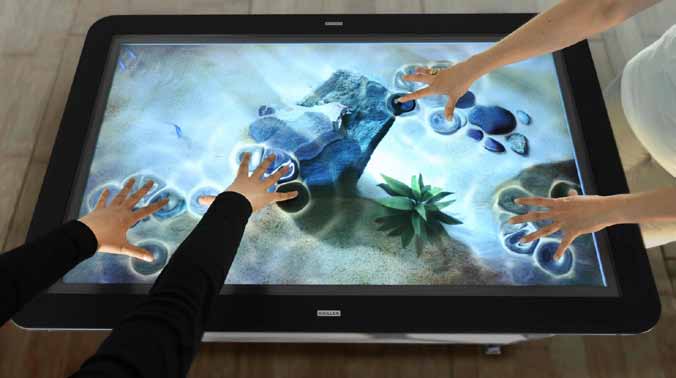
JUNE 2011: Input, output and other peripheral technologies can make or break innovations. For example, no matter how small a chip becomes, a computer or mobile phone cannot become smaller unless its display too becomes more compact. Similarly, however powerful a graphic processor is, its skills cannot be manifested in a device unless the display cooperates. Nanotechnology, three-dimensional (3D) integrated circuits, solar-powered electronics, low-power devices or whatever be the next revolution in electronics, it cannot take off without the help from the display space.
There is a lot happening both in terms of the enabling technologies and the resulting experiences. Micro electromechanical systems, organic light-emitting diodes, surface-emission displays and high-speed phosphor are some of the notable technological advancements, while high-definition, 3D and multi-touch displays are some of the latest experience packages. Some of these are already mature and in the market, while others are still on the anvil. Yet others are still a promise of what the future holds for us.
The magic of multi-touch
Popularised especially by Apple and Microsoft, multi-touch technology is all over the place today. Multi-touch refers to a touch-screen display’s ability to simultaneously register three or more distinct positions of input touches by a stylus or your finger. Brought about by a complex hardware-software team, it enables you to command and control a device through taps, twists and pinches.
A multi-touch display based on capacitive sensing—the most popular technology today—uses a layer of capacitive material to hold an electrical charge. When touched by the user, the charges at the points of contact change. As soon as this happens, a signal is conveyed to the processor, which, in turn, interprets multiple such signals to figure out the position and pressure of the user’s touch, and translates this into respective commands. A pinching movement can zoom-in or zoom-out, and a circular movement can rotate an image, while a swiping movement can flip through pages.
“Multi-touch technology, enabled using capacitive sensing technology, is mostly a separate chip bundled along with different displays. For good performance, the displays should offer a large surface area with less heat dissipation on the screen, making it comfortable for the users to touch with their hands, and a continuous display area without inter-mediate separating bezels,” says Varadha Raju, country head and vice president-operations, Prysm Displays India.
Nihar Mastakar, specialist field applications engineer, Xilinx India, adds, “The advanced software algorithms which are at the heart of the multi-touch sensor chips can easily be run on the Xilinx Zynq-7000—an extensible processing platform (EPP) with dual-core Cortex-A9 MPCore processing system tightly coupled with 28nm programmable logic—making it an enriching experience for the user.”
Multi-touch signifies the start of a journey towards a gesture-based computing era and has become mainstream, thanks to mobile devices like iPhone, tablets and portable PCs such as Apple’s MacBook Pro, Dell’s Latitude and HP’s TouchSmart, and touch-tables like Microsoft Surface. Recent operating systems including Mac OS X, Windows 7, Ubuntu, Apple’s iOS, Nokia’s Symbian, Samsung’s Bada, Google’s Android, Palm’s WebOS, Microsoft’s Windows Phone 7, BlackBerry OS 5.0 and 6.0, and Xandros support touch technology. Windows 7 has many inbuilt touch features, including basic gesture support in Internet Explorer 8.
“The next step in multi-touch technology is gesture recognition, which can make out a user’s command from his action itself without the user having to touch the display,” adds Raju.

high-definition joy
High-definition (HD) video is another buzzword today. It refers to display technologies that work at resolutions of the order of 1280×720 pixels (720p) or 1920×1080 pixels (1080i/1080p).
HD video is a consequence of improved vertical display resolution as well as better interlaced and progressive scanning techniques, among other things. Mainly these two factors together determine the type of the HD display. 720p60 HD, for instance, has a resolution of 1280×720 pixels, with progressive encoding at 60 frames per second (60 Hz). The 1080i50 format is 1920×1080 pixels, with interlaced encoding at a speed of 50 fields per second.
HD video is broadcast digitally or written on Blu-ray discs. Today, most brands offer HD-capable televisions and computer monitors and many television channels have HD offerings. HD content is also available on the Web.
Mobile phones going the HD way. Nokia’s N8 and iPhone4 are some of the recent devices equipped with HD display. There is a buzz around the all-new display technology in iPhone4. Termed as Retina by Apple, it is essentially a high-end screen with four times as many pixels as a same-sized screen. It features a resolution of 960×640 on an 8.9cm (3.5-inch) display, with an 800:1 contrast ratio. Retina technology packs almost 78 per cent of the iPad pixels into the iPhone, but in a much tinier screen.







